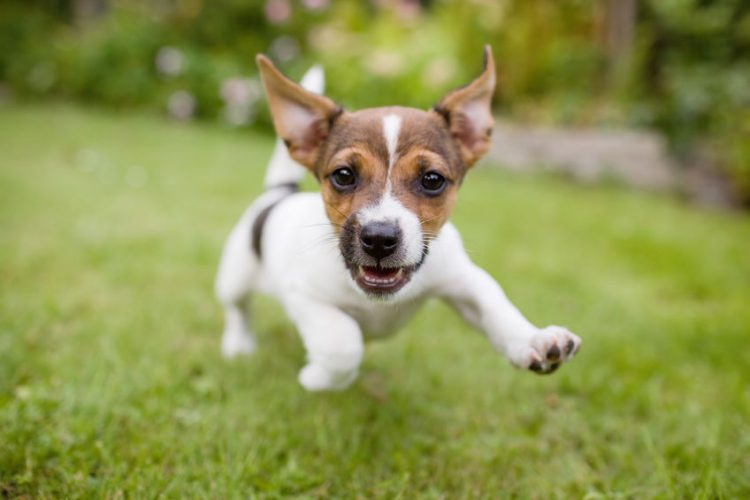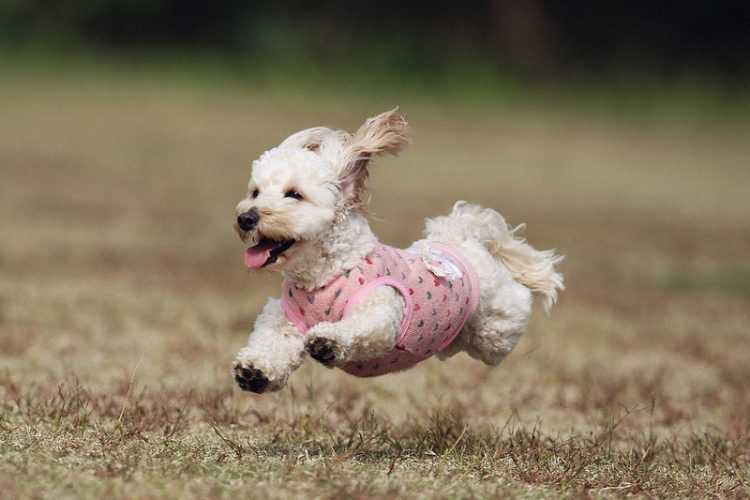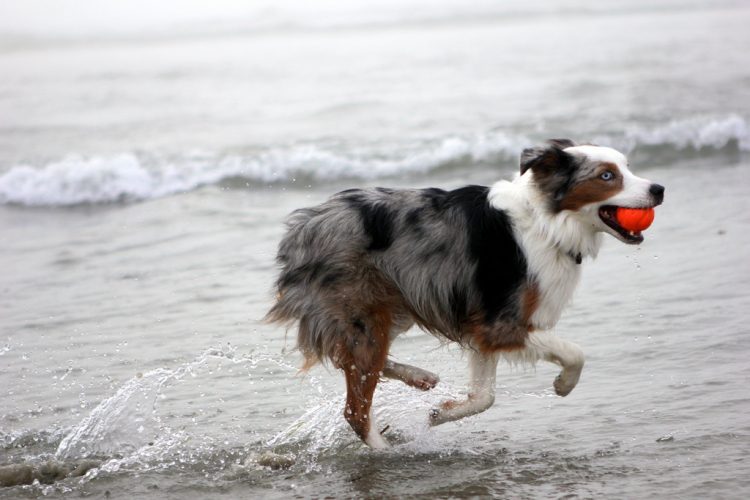
New York City settled a hot topic years ago, when Parks & Recreation decreed that dogs can be off leash from 9 p.m. to 9 a.m. in many large parks, legalizing an already common practice.1
Dog haters and dog lovers seem to be co-existing under this plan.
People have all day where they don’t run the risk of being slobbered or trampled on. In the evening or early-morning hours, dogs have an opportunity to run free — supervised, of course.
Why Dogs Thrive With Exercise
It’s a well-respected theory that dogs are less aggressive when allowed to socialize, run free and exercise.2
Dog bite reports in New York have plummeted in recent years.
Yeah! I am all in favor of tons of exercise for most dogs. A majority of my “behavior” cases in my clinic have to do with the dog in question not getting enough exercise. Many people with dogs just don’t get it.
A report on NPR found that dogs, like humans, can achieve “a runner’s high” from aerobic exercise.3
With long-distance running, our bodies make drugs called cannabinoids. When researchers put dogs on a treadmill, they too produced the drugs. (Ferrets on a treadmill? They didn’t produce anything.)
Conclusion? Dogs, like humans, can feel better and act happier, with exercise.
This, however, is often a double-edged sword: Dogs with a lot of pent-up energy who need lots of exercise may also be the dogs who lack training. Train first, run later.
3 Benefits of Off-Leash Running for Dogs
After intense training, if your dog’s temperament and your environment lend themselves to the safest possible off-leash running, your dog can benefit from the freedom to exercise and explore as well as the freedom of expression.
Here are 3 benefits of off-leash running for dogs:
1. Exercise
As we mentioned, running is good for the body and soul. Many of my patients’ behavior problems are caused or intensified by lack of exercise.
Destructive behaviors, inappropriate jumping or vocalizing, separation anxiety and even house soiling can be helped with more exercise.
2. Explore
Exploration enriches your dog’s life. They get to stop along a run to sniff, poke (no porcupines, please) and paw.
Freedom gives those busy noses, eyes, ears and feet stimulation.
This improves your dog’s mental agility.
Was YOUR Pet Food Recalled?
Check Now: Blue Buffalo • Science Diet • Purina • Wellness • 4health • Canine Carry Outs • Friskies • Taste of the Wild • See 200+ more brands…

3. Expression
Think of a field with a pond, for example.
Some dogs run right into the water without a moment’s hesitation. Others stand by the water’s edge, transfixed by the ripples of a fish or a frog.
Bruno might run into the field, stop, wiggle and roll, while Pickles runs in circles and Tinkerbell jumps in the air for joy.
Physical and mental exercise is great for your dog. As long as you assess your dog’s temperament, train extensively and take every safety precaution and accept but minimize the risk, freedom to run free is a wonderful gift for both you and your dog.

Why “Off Leash” Is Getting Bad Press Lately
Now, try actually finding that real open space to run your dog. It’s a problem!
Some municipalities are growing less and less dog friendly.
Wildlife protection is a valid reason to leash dogs. Many areas restrict dogs during nesting time in early spring. But I think wildlife and habitats could co-exist with off-leash dogs if you have a handle on your dog’s behavior.
Besides wildlife, the biggest concerns are, basically, aggressive dogs, and dogs without manners.
This is because many people are oblivious to what is considered appropriate off-leash etiquette. Those who don’t keep their dogs from jumping and slobbering on people are giving all unleashed dogs a bad rep.
In Boulder, Colorado, you’re required to register your dog and take a special class in off-leash etiquette before your pup runs free.
The Rules Where I Live — And Why They Matter
Amherst, Massachusetts, where I live, is home to Amethyst Brook. This is a beautiful conservation area where, for many years, dog walkers and human walkers co-existed.
But now? Well, dogs can be off leash only from dawn until 10 a.m.
Here’s my position on this as a veterinarian and a dog lover: I’m actually in favor of the leash law at Amethyst Brook.
Why? Because safety for everyone wins out. The area simply became too crowded, and people didn’t take responsibility for their pets’ behavior.
Recently, 2 of my biggest emergencies happened at Amethyst:
- First, an older cockapoo — on leash — was attacked by a dog off leash. Two surgeries later, after surgical drains, lots of pain and anti-anxiety medication, the victim was recovering. But, like all dog fights, this was a harrowing experience, for dogs and humans alike.
- My second emergency was more upsetting. Someone failed to leash his young, free-spirited dog upon leaving the conservation area, and Dexter was hit by a car. He survived but suffered painful injuries to the foot, pad and hip. If this young dog was far enough away from his human to be out of sight, and wasn’t trained to voice commands, he didn’t deserve to run free where he could injure someone or, unfortunately, be severely injured himself.

Top Rules of Off-Leash Etiquette
Off-leash running is a true joy for both you and your dog.
But let’s stop right here. It can also be dangerous.
Your dog’s personality, your environment and your training protocol dictate whether off-leash running is a possibility — but this isn’t to say that I recommend it.
Here are some guidelines to consider if you are thinking about running free with your dog:
1. Teach your dog to listen.
If you have a puppy or a dog who does not understand simple commands like “down” or “off,” they should not be able to greet a person on a trail with “Here’s mud in your eye.”
2. If you have a dog-aggressive dog, make sure the area is very unpopulated.
Or be able to leash the dog if you come upon another canine. This may be next to impossible if other dogs run up to your aggressor.
I have sympathy for this problem. My favorite dog, Bruno, was an 80-pound Border Collie mix who loved people yet hated strange dogs.
I finally got him to stop and stand when another dog approached so I could leash him. But we traveled off leash in remote areas. He had a few ugly moments with other aggressive dogs. Both people (that means me too) were to blame.
3. If your dog is soaking wet, don’t let them dry off on dry people.
Your pet may be having a field day at the pond, but other people might have to go back to work. In dry clothes.
4. Don’t let your dog hump people who are sitting down.
Did I even have to say this?
5. Keep your dog away from all picnic areas. Don’t let them urinate on personal items.
Did I have to say that? I guess I did.
6. Pick up the poop!
Even if nobody is watching.
Does a dog —- in the woods? Of course they do.
Is it biodegradable? Sort of, but not instantaneously on the bottom of your flip-flops.
7. Don’t play stick and encourage barking where people are resting.
Find the “active” part of the park where the jocks are throwing Frisbee.
No Guarantees
Off-leash running always poses a risk.
You cannot control outside stimuli, such as the appearance of another dog, people, bicycles, loud noises or scampering woodland creatures.
Any of these could trigger even a well-trained dog to ignore voice commands.
Training, Training, Training
Extensive training, specifically off-leash training, is essential.
Hire a trainer who specializes in off-leash techniques.
Or try it yourself: The internet is filled with good articles on how to train your dog to go off leash.
If you are beginning with a puppy, begin simple puppy training immediately. Your goal is to produce an exceptionally well-trained dog who responds to voice commands even under complicated circumstances.
And, of course, it almost goes without saying — never let a puppy run free.
All Dogs Are Not the Same
Some dogs will never be able to reliably run free, regardless of the training.
These include:
- Frightened or shy dogs
- Breeds with a strong prey drive
- Hunting dogs without solid training
- Dogs with stubborn temperaments or aggression issues

“But My Dog Is Friendly” Isn’t an Excuse
Your dog may be the wiggliest, cuddliest, sweetest pup ever, but their temperament isn’t an excuse to have them off leash in a public area.
A lot can go wrong:
- They can scare someone. A lot of people are terrified of dogs — even your cute pup who wouldn’t hurt a fly.
- They can approach the wrong dog. Lots of dogs are aggressive toward other dogs or are leash reactive. If your dog isn’t on a leash, you’ve lost your most powerful tool to stop a dog fight before it starts.
- They can run into traffic. Even the most well-trained dog will probably have a hard time ignoring a squirrel or bunny or cat that darts out in front of them.
You can safely have your dog off leash in designated places. If you’re not sure what the leash rule is, err on the side of safety — keep the leash attached.
Location, Location, Location
Rural Settings
These areas afford the best options for leash-free running.
Trails and fields far away from traffic, protected conservation areas and dog-friendly beaches and lakes are paradise for dog adventures.
Voice command is still essential, however, no matter how remote or unpopulated the area. Training is the key, and so is knowing that no off-leash running is ever 100% safe.
Suburban Areas
They often provide large outdoor spaces, trails and dog-friendly parks.
But if your suburb is densely populated, be wary of your proximity to traffic, people, dogs and children.
The quick, jerky movements and no-boundary behaviors of children can startle even a well-behaved dog. No off-leash running around unfamiliar children.
Urban Areas
Cities have few off-leash opportunities as a rule. Large city parks may have areas designated as dog-friendly, and there are always dog parks.
Dog parks have their own set of safety issues, and some dogs may love other dogs on a walk but never seem comfortable in a dog park.
Once the leash comes off, this dog knows exactly where to go:

Final Thoughts on Off-Leash Etiquette
There will always be people who hate dogs. And that is their loss.
Personally, I don’t trust these people and worry about them. But we don’t need to make them hate dogs more. So abiding by some simple rules gives the rotten dog haters less to complain about.
References
- “Parks Barks Official Off-leash Hours Policy.” NYC Parks. May 10, 2007. https://www.nycgovparks.org/news/press-releases?id=19895.
- Menor-Campos, D.J. et al. (2011) “Effects of exercise and human contact on animal welfare in a dog shelter.” Veterinary Record 169, 388.
- Joyce, Christopher. “‘Wired To Run’: Runner’s High May Have Been Evolutionary Advantage.” NPR. May 7, 2012. https://www.npr.org/sections/health-shots/2012/05/07/151936266/wired-to-run-runners-high-may-have-been-evolutionary-advantage.
This article on off-leash etiquette for dogs was written by a veterinarian, Dr. Debora Lichtenberg, VMD. Former animal shelter worker Allison Gray contributed to this article. It was last updated Nov. 20, 2018.



